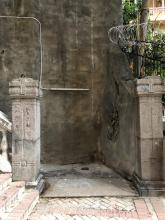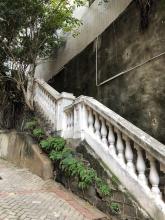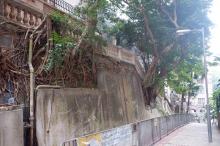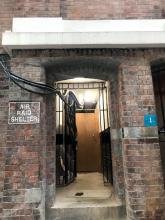Kung Ho Terrace / 共和台 [????-????]
Primary tabs
Submitted by Raymond Lo on Thu, 2020-02-06 17:54
Current condition:
Demolished / No longer exists
Kung Ho Terrace[共和台]is a small terrace between Babington Path and St. Stephen's Lane at the Mid-Level. The terrace had five adjoining two-storey mansions with a small gardens by the main doors. All five mansions had been re-developed. The price of a mansion after World War Two was $45,000 Hong Kong Dollars. The name Kung Ho Terrace had not probably been used since 1950s.





Comments
A 1933 Chinese language
A 1933 Chinese language reference book for the Chinese living in Hong Kong had the name Kung Ho Terrace[共和台] in its Hong Kong Island street name list. The exact date of the building of Kung Ho Terrace is pending further research.
The meaning of Kung Ho [共和]
Kung Ho[共和] means the five main peoples of the Republic of China[中華民國] living harmoniously and peacefully together after the overthrow of the Qing Dynasty[清朝].
KUNG HO TERRACE
The balusters look the same although the lower few sections were rebuilt. you can see the horizontal parts - both the color and shape remains original.
I lived in 11 St. Stephen's lane / Kung Ho Terrace from 1977-90 and it was such a nice and quite little place, still remember the very old house (most likely built in the early 1900s ) at the end of the Terrace with nice and sweet fruit tree (called the Yellow skin ?) in the front yard. back then the population was only 3-4 person per household so everybody knows their neightbours.
The two granite pillars at bottom of stairs are most likely 100-110 years old and the steps going up to the terrace are also made of granite.The two granite pillars still has chinese character "Kung Ho Terrace" carved on it although the painted color is faded. if you look carefully part of the hand written chinese character still shows a bit on the left stone pillar, which was written "St. Stephen's lane 6-12 Kung Ho Terrace" written in vertical chinese format. Those red characters were very clear in the 1970's. The retaining wall, now covered with sprayed cement - was built with large stone masonary to create the "terrace" from the slope of the mountain. This is the same construction like the lower stone wall which can be seen alone the old section of St. Stephen's lane as well as the "tree wall" at Bonham road bus station. When I was a kid 6-7 years old living in 35 Bonham road, I used to walk through St. Stephen's lane just by myself to go to school at the Rhenish Church. Those were the days in the 60's.